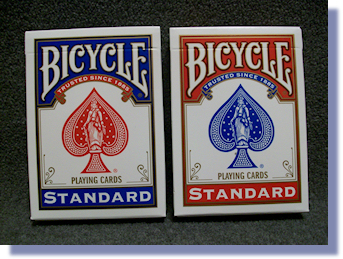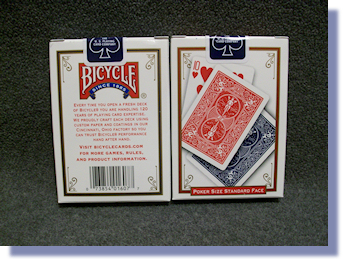Camera Trick
Described By Jeff Stone
Introduction
This is yet another effect that takes advantage of the new Bicycle card boxes. This is an idea that Dan just came up with off the top of his head over pizza one day. The guy is a genius.
Effect
The pasteboard prestidigitator shows gives the audience a brief lesson in the history of cameras via the use of – you guessed it – playing cards. First a blank card (representing old-school Polaroid film) is shown on both sides and placed in between a red back Joker and a blue back Joker. The three cards are then placed inside the camera (card box).
A card is chosen. The magi/photographer aims the camera card box at the selection and the box clicks (snaps a picture). The “film” is removed from the box to show that a picture of the card has developed. The blank card is no longer blank. Next the freelance photographer points out that today, we use digital cameras. He then points the card box at the three cards (two Jokers and selection) laying on the table and “shoots” a picture. The card box is then shown to have actually printed on the card box an exact copy of the cards as they lay on the table. The card box has a permanent picture of the cards that were laying on the table, and the card box is examinable.
Props
- The New Bicycle Standard Style Card Boxes
- A red backed Joker
- A blue backed Joker
- A blank backed Ten of Hearts
Note
I recognize the fact that a Blank Backed Ten of Hearts isn’t exactly the easiest thing to get a hold of. The best thing I can tell you is either order a blank back deck (they’re about 8 bucks) from your favorite magic dealer, or make one by splitting a blank facer and a Ten of Hearts, then putting them together. There are many resources for splitting cards. I teach a very basic partial splitting of a card in my Gemstones DVD, but you’re likely better off getting a Card Splitting DVD such as The Art of Card Splitting.
As for the deck of cards, below are images of what they look like. Click on an image to enlarge it.
When I published Diamond Jim’s Effect, The Standard, in the April 2009 issue, I got many emails saying that people could not find the cards anywhere. Here in Salt Lake City, Utah, I can’t find regular cards. I can only find these new ones, so if you’re having a hard time finding them in your area, you can now purchase them from my site for $9.95.
Method/Performance
The method should be pretty clear at this point. Inside the case you have the red backed Joker, the blue backed Joker and the blank backed ten of hearts between them. The case is “ten-side” down. The only thing in the box is those three cards. The deck is out of the box, and you will use it to force the Ten of Hearts. Lay the Ten face up on the table.
Remove the three cards from the box. Remove the Ten blank side up with the right hand. As you set it on the table for a brief second (so that you can display the two Jokers – one in each hand), do a false turn-over move to apparently show both sides of the blank back card as if the card is blank on both sides. If you are not familiar with the false turn-over move, then go talk to you magic buddies or go to a magic club meeting and ask someone. Get off the dang computer and interact with some humans!
With one Joker in each hand show them and claim that these Jokers represent the chemicals used in old Polaroid cameras and that the blank card on the table represents the Polaroid film. Place both Jokers face up in the left hand. Place the Ten (blank side up) in between the two Jokers.
Place the three cards back in the box. Hold the box with the long end parallel to the floor, with the back of the box toward you and out of the spectator’s line of vision. Aim the box at the forced Ten on the table and click the box just like you would if you were clicking to take a picture (a Fism flash would be a nice addition here if you’ve got one).
Open the box and remove the three cards and remove the Ten from between the Jokers to show that you actually took a picture of the card on the table. Casually toss the newly created Ten on the table face up, then seemingly casually place the red and blue Jokers on top of the face up ten so that it looks like the picture on the back of the box (see the image above).
Then as an afterthought, you mention the fact that these days, people don’t use Polaroids. Everything is digital, and you can preview the image even before you decide to print it. Then you point the box at the tabled three cards. This time you are holding the box with the short end parallel to the floor. The back is still toward you. You then pretend to snap another picture after which you reveal the back of the card box to the audience to show that you captured the picture of the cards as they lay on the table.
Extra Ideas
Idea 1:
Rather than using Jokers, you could use a red blank facer and a blue blank facer. This is a little more complex, but it gives you a really nice show of a blank card on both sides. Here’s the set up: place the two blank facers face to face. Then place the Ten face down (blank side up) on top of the two face to face cards. You can now do a block pushover double to apparently show both sides of the blank card as being blank. Once you’ve done the double turnover, you’ll be left with the Ten sandwiched face up between the two face up blank facers.
You will not, of course, reveal this. However, you will turn the entire three card packet face down and perform the glide to apparently place the bottom card on the table. However, due to the glide, you will will end up placing the Ten blank side up on the table thus leaving you with the red and blue cards face down in your left hand. From the audience’s perspective, you’ve just shown a card to be blank on both sides and placed it on the table. Next show the red and blue cards, one in each hand and proceed as in the original version.
Idea 2:
Another little tip you can do that will add a little depth to the effect is cover the back of the case to hide the picture of the Ten. To do this, when removing the cellophane wrapper from the deck, just remove the top portion and leave the bottom portion in tact. If you remove the plastic right at the pull strip, you will find that you can leave the cellophane wrapper on the bottom 3/4 of the box.
The wrapper will come right up to the bottom of the half moon on the back of the box. Next, slip the red backed Joker (or blank facer if you are using Idea 1 from above) between the cellophane and the box with the red back showing. This will make the box look like an ordinary Bicycle box.
Then place the other two cards inside the box. Now the box can be shown freely on all sides. In performance, show the box around (casually), and rattle it as you deliver your presentation. You rattle it so that the audience can hear that there is “something” inside. Hold the box close to them so they can see both sides. You might even say something like, “There is something inside. Can you hear it? It’s inside, not here on the outside and not here on the outside, but here, in the inside.”
As you say the words “not here on the outside” point to one side of the box. Then as you say those words again, turn the box over and point to the other side of the box. Later they’ll remember that they saw both sides of the box. In order to remove the card, simple open the box (moon side down), and when you pull the two cards out of the box, also make sure you grab the card on the outside of the box and let it slide along the other two for the ride.
By the way, in order to pull this steal off effectively, you’ll need to make sure you’ve removed the half-moon sticker. So that’s it; I hope you enjoy this effect. It has a lot of presentational potential and is a good effect to really allow your performance personality to flourish.
Please Take a Moment to Reply To and “like” This Effect.


